by James Scott Bell
@jamesscottbell
 Today I begin an occasional feature—JSB at the Movies. I’m a lifelong movie fan, my B.A. is in Film Studies, and I often use movie clips in my craft workshops. The crossover between screen and page storytelling is substantial.
Today I begin an occasional feature—JSB at the Movies. I’m a lifelong movie fan, my B.A. is in Film Studies, and I often use movie clips in my craft workshops. The crossover between screen and page storytelling is substantial.
So let’s start with one of the best.
Frank Capra’s It’s A Wonderful Life was not always a beloved Christmas classic. That’s because it was rarely seen after its initial run in 1947. When movies started showing up on TV in the 50s, Wonderful Life was tangled up in issues over ownership and copyright. That cloud did not begin to dissipate until 1974, while I was a film student at U.C. Santa Barbara. That year the copyright owner, Republic Pictures, failed to renew (probably due to a clerical error) and the film fell into public domain. That’s when it started showing up on TV for new generations to embrace.
To celebrate the movie’s new life our film department arranged for a showing, with a special guest—Frank Capra himself.
Capra is one of my all-time favorite directors. So I wangled and cajoled my way into being named his chauffeur for the evening.
Not that it was a glamorous ride—it was in my scruffy, three-on-the tree Ford Maverick. But the greatest populist director, the champion of “the common man,” did not seem to mind at all getting ferried to the campus in a rattletrap student automobile.
Along the way I told him my two favorite movies of his were It Happened One Night and Mr. Smith Goes to Washington. I added that my dad was an extra in Mr. Smith. Capra told me of the cold reception that film received when it was shown in D.C. Apparently the senators did not take kindly to the way their chamber was depicted. (Sheesh, what would a Capra film do to them today?)
Campbell Hall, our big auditorium, was packed. I got to do the introduction. Mr. Capra made some opening remarks, and then we watched the movie.
It knocked me out. And, I daresay, had the same effect on most of the audience. We had just been gifted the magic of what critics called “the Capra Touch.”
A Frame Story
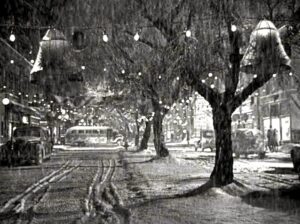 Wonderful Life begins and ends on the same Christmas Eve, in a town called Bedford Falls. It opens with shots of the snowy town, and the voices of various townspeople praying for a man named George Bailey. The last voice is the one we’ll come to know as Zuzu (George’s youngest child) pleading, “Please bring Daddy back!”
Wonderful Life begins and ends on the same Christmas Eve, in a town called Bedford Falls. It opens with shots of the snowy town, and the voices of various townspeople praying for a man named George Bailey. The last voice is the one we’ll come to know as Zuzu (George’s youngest child) pleading, “Please bring Daddy back!”
We then switch to the heavens, where angels (in the form of twinkling stars) talk about what do to answer these prayers. The assignment is give to an angel named Clarence who hopes to earn his wings.
The film switches to the linear story of George, from boyhood to the present. He’s a man with hopes and dreams who comes to think of himself as a failure; indeed, that it would be better for everyone if he were dead.
This is when Clarence the angel intervenes.
This film ends by returning to the frame—Christmas Eve—and George’s redemption. A bell on the Christmas tree rings. Zuzu announces, “Teacher says every time a bell rings an angel gets his wings.”
George winks at the sky. “Attaboy, Clarence.”
Lesson: A frame-story can add another level of emotion if you make it entertaining in its own right. A frame-story can add another level of emotion if you make it compelling in its own right. Other movie examples using this device are The Princess Bride and Titanic. Novels with a frame include The Ocean at the End of the Lane by Neil Gaiman, The Notebook by Nicholas Sparks, and The Green Mile by Stephen King.
The Imperfect Lead
Heroes who are perfect are uninteresting. Deep down we don’t really buy it. That’s why your Lead should have flaws and foibles just like all of us.
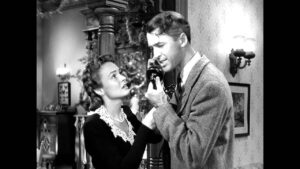 George Bailey (James Stewart) is a good man, a solid citizen, but is far from perfect. He’s not above leering at the attractive derrière of Violet Bick (Gloria Grahame) as she shimmies down the street. He loses his temper and becomes abusive. He verbally destroys the simple-minded Uncle Billy when the latter loses a crucial bank deposit. On Christmas Eve, his life at its lowest ebb, he screams over the phone at his child’s teacher, then yells at his children, bringing them to tears. (Stewart’s acting is brilliant throughout. He was suitably nominated for Best Actor, losing only because the equally brilliant Frederic March in The Best Years of Our Lives.)
George Bailey (James Stewart) is a good man, a solid citizen, but is far from perfect. He’s not above leering at the attractive derrière of Violet Bick (Gloria Grahame) as she shimmies down the street. He loses his temper and becomes abusive. He verbally destroys the simple-minded Uncle Billy when the latter loses a crucial bank deposit. On Christmas Eve, his life at its lowest ebb, he screams over the phone at his child’s teacher, then yells at his children, bringing them to tears. (Stewart’s acting is brilliant throughout. He was suitably nominated for Best Actor, losing only because the equally brilliant Frederic March in The Best Years of Our Lives.)
Lesson: The imperfect Lead creates empathy. The key, however, is that he is aware of his flaws, and wants to overcome them, as George does.
Strong Supporting Characters
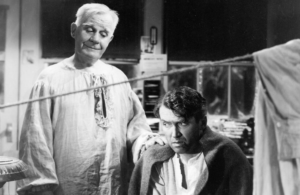 Every one of the secondary characters in Wonderful Life is well-drawn and engaging in their own right. Clarence the Angel (Henry Travers); Bert the cop (Ward Bond); Ernie the cab driver (Frank Faylen); the tragic Mr. Gower (H. B. Warner); all the way down to Zuzu (Karolyn Grimes, who is still with us). Old Man Potter (Lionel Barrymore) is a classic villain, and even his nonspeaking servant has an eerie presence.
Every one of the secondary characters in Wonderful Life is well-drawn and engaging in their own right. Clarence the Angel (Henry Travers); Bert the cop (Ward Bond); Ernie the cab driver (Frank Faylen); the tragic Mr. Gower (H. B. Warner); all the way down to Zuzu (Karolyn Grimes, who is still with us). Old Man Potter (Lionel Barrymore) is a classic villain, and even his nonspeaking servant has an eerie presence.
Lesson: Give each of your supporting characters, even the minor ones, their own unique quirks and tags. These add “spice” to your stories, increasing reader enjoyment.
A Rocky Romance
At the heart of the film is the love story of George and Mary (Donna Reed). When George’s brother, Harry, returns to town, married, George learns he’s been offered a great job by his father-in-law. Harry tells George he’ll keep his end of the bargain by running the Building and Loan so George can travel, but George knows the job is best for his brother and sister-in-law, and tells Harry to take it.
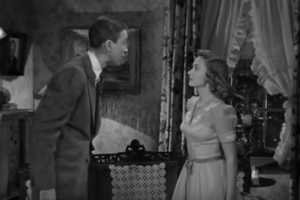 Which doesn’t help George’s frustration about staying in town. That evening he finds himself walking by Mary Hatch’s house. Mary, back in town from school, has been waiting for this moment. She has on her best dress and has set up the parlor to reveal a picture of a romantic moment from their high school days—when George said he would “lasso the moon” for Mary.
Which doesn’t help George’s frustration about staying in town. That evening he finds himself walking by Mary Hatch’s house. Mary, back in town from school, has been waiting for this moment. She has on her best dress and has set up the parlor to reveal a picture of a romantic moment from their high school days—when George said he would “lasso the moon” for Mary.
But that was then.
Now, as Mary does everything she can to rekindle the romance, George shoots her down at every turn. Finally Mary has had enough. She smashes the phonograph record of “Buffalo Gals” just as she receives a phone call from her suitor, Sam Wainwright. Sam asks to speak to George. He proceeds to offer George a “ground floor” position at his new plastics firm.
Mary…plastics…money…
George’s turmoil explodes to the surface. He grabs Mary by the shoulders, shakes her. “Now you listen to me! I don’t want any plastics! I don’t want any ground floors, and I don’t want to get married – ever – to anyone! You understand that? I want to do what I want to do. And you’re…you’re…”
George pulls Mary to him in a fierce embrace. Love has conquered his rage.
Lesson: Readers love to read about love. But be it a romance plot or a romance subplot, the path of love must have obstacles. In a scene of high intensity, find a competing emotion that fights for supremacy inside the character.
The Mirror Moment
There’s a perfect mirror moment in the middle of the film. George is forced to look at himself and choose what kind of man he’s going to be.
Old man Potter has been trying to take over—or ruin—the Bailey Building and Loan Company, so his firm will be the only one building homes for the community. But George has frustrated those plans. And while he’s now married with children, George is not rolling in dough like his friend Sam Wainwright (see above) who made a killing in plastics during the war.
Knowing this, Potter calls George in for a meeting and hands him a big, fat cigar. He starts with the flattery, then offers George a job—at ten times George’s current take-home!
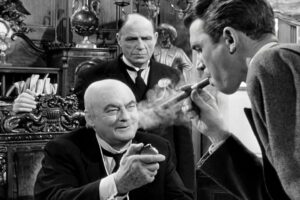 “You wouldn’t mind living in the nicest house in town,” Potter says, “buying your wife a lot of fine clothes, a couple of business trips to New York a year, maybe once in a while Europe. You wouldn’t mind that, would you, George?”
“You wouldn’t mind living in the nicest house in town,” Potter says, “buying your wife a lot of fine clothes, a couple of business trips to New York a year, maybe once in a while Europe. You wouldn’t mind that, would you, George?”
George is stunned. And tempted! To travel like that has been his dream. To have money to lavish on his wife, who has had to make the best of his meager salary, has always been his desire. He’s considering the offer when he asks what will become of the Building and Loan.
“Confound it, man, are you afraid of success?” Potter says. “I’m offering you a three-year contract at twenty-thousand dollars a year, starting today. Is it a deal or isn’t it?”
We read the conflict in George’s eyes. Who am I? he is thinking. What will happen if I take this offer?
He asks Potter for a day to think it over. Potter consents, tells George to go talk it over with his wife and meanwhile he’ll draw up the papers. He offers his hand.
The script describes what happens next: As they shake hands, George feels a physical revulsion. Potter’s hand feels like a cold mackerel to him. In that moment of physical contact he knows he could never be associated with this man. George drops his hand with a shudder. He peers intently into Potter’s face.
George says: “No…no…no…no, now wait a minute here! I don’t have to talk to anybody. I know right now, and the answer is no. NO! Doggone it!”
George has decided who he must be, but will that be enough to sustain him? That’s what the rest of the movie is about.
Lesson: At some point in your writing—the planning stage or at any point along the pantsing highway—brainstorm five possible deep questions your Lead can ask about himself. What is the central inner issue at this point in the story? You’ll often find that the third, fourth or fifth idea is the one that jumps out at you as original and on point. And that’s when you know what your story is really all about.
Transformation
At the end of every great story is a transformation of the Lead. In this case, George is transformed from a bitter and discouraged man to one who has realized that his gift to the world has been right there in his little hometown. Because of his sacrifices and generosity, Bedford Falls is a lovely place to live, as opposed to the Pottersville of the alternate world (where George had never been born).
Note that this transformation is an answer to the question raised by the mirror moment.
And here’s a little technique that will add depth to all this: the argument against transformation.
That’s a beat early in Act 1 where the Lead makes a case for the opposite of the transformation. For example, Rick in Casablanca is transformed into a self-sacrificing hero at the end. So what does he say early on? “I stick my neck out for nobody.”
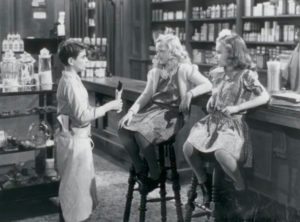 In Wonderful Life, George’s realization about his town’s love is argued against in Act 1. That’s when the young George Bailey tells the two girls, Mary and Violet, the following:
In Wonderful Life, George’s realization about his town’s love is argued against in Act 1. That’s when the young George Bailey tells the two girls, Mary and Violet, the following:
You don’t like coconuts! Say, brainless, don’t you know where coconuts come from. Lookit here – from Tahiti – Fiji Islands, the Coral Sea!
MARY: A new magazine! I never saw it before.
GEORGE: Of course you never. Only us explorers can get it. I’ve been nominated for membership in the National Geographic Society. I’m going out exploring some day, you watch. And I’m going to have a couple of harems, and maybe three or four wives. Wait and see.
Lesson: Once you know the transformation, give your Lead a line or two in Act 1 that is expressing the opposite view. The readers will experience a most satisfying character arc that way.
And that is why It’s a Wonderful Life is a classic of its time—and for all time.
This is JSB at the Movies, signing off.
The End.

This is like Christmas! Frank Capra is my favorite director, James Stewart is my favorite actor, and It’s a Wonderful Life and Casablanca are two of my favorite movies.
Every year I wrap Christmas gifts while watching It’s a Wonderful Life. I knew I loved it but I didn’t realize there was so much going on at every level.
I’m a sucker for good Christmas movies in general, which is one reason why I’m working on my own. I hope Christmas Wishes turns out to be as magical as this beautiful story.
Right on, Cynthia. Capra and Stewart, hard to beat.
I’ve long wanted to write a Christmas story, too. But it is so difficult to come up with a great concept. So many classics have already been done , e.g. my favorite Christmas movie, Miracle on 34th Street.
Jim, thanks for the deconstruction. You explained exactly what qualities made this classic movie stand the test of time.
Casablanca was recently re-released to theaters for its 80th anniversary. After watching it on TV many times, I finally saw it on the big screen. Really cool.
For a future post, how about deconstructing a Billy Wilder movie or two? His range from heavy drama to slapstick comedy was amazing.
Great idea, Debbie. Billy Wilder is one of my favorite directors. It will be hard to choose which one to do!
I’ve never seen Casablanca all the way through, just pieces of it.. So, when acquaintances invited me to have dinner at their church, followed by a screening of Casablanca. I was looking forward to seeing all of it, at last, Dinner had a mid-Eastern theme and was excellent, if a bit expensive. About halfway into the movie. Mr. X said he didn’t care for it and Mrs. X drove us back home.
Thanks for the wonderful analysis of one of my favorite movies. Had you seen the film before the showing in 1974?
I had not. A high school friend of mine, another Capra fan, had seen a bootleg print somewhere and told me all about the movie. So glad I first saw it on the big screen.
Thanks, Jim. Your story about meeting Capra and your analysis of the film make me want to watch it, here in the second half of May.
Hope you’re having a great weekend!
It’s good any day of the year, Joe! Enjoy.
Thanks, Jim, for the deconstruction of the movie/story. Wonderful.
And congratulations on the new special series, “JSB at the movies.” We’ll all have to bring popcorn to our Sunday at the movies. The logo reminds me of the old 16mm reel-to-reel projector I had to set up Sunday evenings at our church as a boy. I can still hear the clicking.
I look forward to future film dissections.
So many great films to choose from, Steve!
Good morning, Jim! I’m thrilled that you’re beginning a series on JSB at the Movies. It’s a Wonderful Life is a Christmas staple in our home. Your deconstruction adds much to the enjoyment, although I still don’t have a good handle on the meaning of a Frame Story. Maybe you can say a little more about that.
Another thing I love about IAWL is the humor. All throughout the story of a man going through disaster, the joy shines through.Thank goodness for the clerical error that gave us the gift of this movie — it’s popularity gives me hope for our civilization.
Looking forward to your next movie!
Kay, a frame story begins and ends in the same place, with the story proper in between. Princess Bride, for example, starts with the grandpa reading to the boy…the story is told…and it ends with the grandpa saying goodbye and “As you wish.”
Titanic begins and ends with the old woman. In between is her story of the voyage.
Okay, now I understand. Thank you.
Would Lord of the Rings fit into that also, Jim?
Having never been able to get past the first 50 pages of Book I, Deb, I cannot say.
Happy Sunday, Jim! I also love this first installment in your new “JSB At the Movies.” Very insightful deconstruction. I didn’t discover this movie until the 1990s but fell hard for it at once, and have now watched it many times. A few years ago my wife and saw it on the big screen at the Hollywood in Portland, a wonderful theater that opened in 1926. (I also saw Casablanca there, and Lawrence of Arabia more than once.)
You captured the power of the midpoint in “It’s a Wonderful Life.” A very emotional moment for George. It resonated with me on multiple levels. Potter acknowledges George’s unhappiness and sense of not being able to pursue his dreams. Bedford Fall’s Satan is sympathetic, and that attempts to use that sympathy as leverage to get George to fall for the tempting offer, and finally get rid of the one obstacle that has stood in his way.
I love everything about this film. Very cool that you got to meet Mr. Capra and introduce him and the film.
Have a wonderful day!
Dale, some films simply have to be seen on the big screen…ESPECIALLY Lawrence of Arabia! I actually watched it once in my dorm room on a dinky black and white TV. Um, not the same.
Fantastic deconstruction of a beloved movie, Jim. I second Debbie’s idea to deconstruct Casablanca!
I’ll put it on the list!
I remember seeing IAWL in the theatre, particularly the scene where the pharmacist’s error is discovered by George. A year or so later, my dad and I listened to a 50 minute radio adaptation of the film, featuring Donna Reed and Jimmy Stewart. This one, IIRR:
https://youtu.be/u-TXUWidpV4
Thanks for the link!
Love both the actor and the movie. Thanks for the in-depth analysis, Jim!
🙂
My pleasure, Deb.
I loved that movie and loved watching each Christmas—until I married my wife. She hates it with a passion. I still like the movie but there’s a snowball’s chance in hell that I’ll get to watch it with the family. In her viewpoint, there’s a lot of unappropriated scenes.
For example, when the pharmacist slaps young George for disobeying orders. Even though a life was saved, she couldn’t look past a kid getting slapped. Not socially correct along with other snippets.
I enjoyed your refresher and liked the perspective. Perhaps, the movie symbolizes transformation from one era to what acceptable in our times today.
That’s the way it is with all old movies, Ben. But if we refuse to view them for that reason, our loss is incalculable. Imagine refusing to watch Hamlet because he “mansplains” to Ophelia how she’s got to go to a nunnery…and on and on and on….
“…brainstorm five possible deep questions your Lead can ask about himself. What is the central inner issue at this point in the story? You’ll often find that the third, fourth or fifth idea is the one that jumps out at you as original and on point. And that’s when you know what your story is really all about.”
Timely lesson. I’ve got a new lead I’m brainstorming and now’s the time to ask those questions.
On another note, for Dale & others who have worked in libraries, I read that today is U.S. Public Library Day and that the first opened in Connecticut in 1803. I’ve lost count of the amount of time I’ve spent in libraries over the years. 😎
And for all of us, I also came across this quote today:
“Books are the quietest and most constant of friends; they are the most accessible and wisest of counselors, and the most patient of teachers.” — Charles William Eliot
Brainstorming is so much fun, BK. Enjoy!
Thanks, BK for mentioning Public Library day! I gave an online presentation to a writers organization yesterday about utilizing the library as a writer. The library system I worked for here in Portland began in 1864 as a reading room and then expanded into a public library in toward the turn of the 19th/20th centuries. That’s positively old in this part of the country 😉
Whew! One of your best essays, Jim. Great pointers for writers at any level, and with the perfect story to illustrate them.
Thanks, M.C.!
You either love or hate It’s a Wonderful Life. I admit I am one of the haters. What an awful message it sends, that you must give up all your hopes and dreams if you want to be a ‘good’ person. From a storytelling point of view, those are interesting observations though.
Interesting take there, J, but I just don’t see it. George never “give up” his hopes and dreams, but obstacles arise to stop him…hmm, just like real life. Far from giving them up, he sacrifices them for greater goods—his father’s beloved business, his brother’s happiness, heck, the happiness of the entire town which is under the cloud of being taken over by Potter. This is what we used to call everyday heroism.
All of this starts to convince George he’s an abject failure…until Clarence lets him see what he does not…until at the end when Harry toasts “the richest man in town.” Inscribed in the copy of Tom Sawyer Clarence leaves him: Dear George, remember no man is a failure who has friends. Thanks for the wings. Love, Clarence.
Friday was Stewart’s birth anniversary. Happy Birthday to America’s Everyman.
Great advice, James. Film techniques can also be danger for newer writers to emulate in viewpoint. Camera angles aren’t character viewpoint.
As an interesting side note, video techniques are changing viewpoint. Editors frown at sentences like, “His hand ran up and down her back.” They prefer, “He ran his hand up and down her back.” Body parts should not act independently according to editor thought.
However, many writers now prefer, “His hand ran up and down her back” because they see this as a close-up in their mental video of the action, and it is beginning to creep into published writing.
In a few years, this type of video technique may be as common in genre narrative as the other changes we have seen.
Stewart was truly one of the great actors. From an “aw shucks” persona pre-WWII, he served heroically in the war in the Army Air Corps, flying some twenty bombing missions over Germany. When he got back he was no longer “aw shucks,” and took on more complex roles like George Bailey and in films like Rope and Call Northside 777.
Then in the 50s he made some truly great Westerns with Anthony Mann. Tough as nails in those.
And on and on. One of his best performances is in Anatomy of a Murder. And I’d even include his voice acting as Wylie Burp in An American Tail: Fievel Goes West.
Jim Bell teaching about movies (especially classic movies). What a great way to spend a Sunday. Thanks. It’s A Wonderful Life is free on Prime Video right now, so I think I’ll treat myself (even if it is a colorized version and I’d rather see the original B&W). Love Frank Capra films. Thanks for the great tips.
Well now, Robin, we purists would never allow our eyes to gaze upon a colorized version of any B&W film, especially this one! But if it’s free and you’re of a mind, I won’t stop you! But only this one time…
Interesting detail on how IAWL came to be so popular, or at least shown everywhere. I’d never heard of it as a kid. A small theatre in Seattle, The Grand Illusion, started showing it every December sometime in the 70s, no doubt after it went PD. I got dragged to it (by a friend) late in high school. This was the first time I had heard of it or seen it. Now it’s neck and neck with A Christmas Story for the Movie You Can’t Escape in December.
Another great frame flick: Sunset Boulevard.
I look forward to your breakdown of Casablanca, because of course that’s high on your list. Right?!
Sunset Boulevard and Casablanca are vying for next!
One of my favorite movies. The idea from the movie that resonates with me is that you never know what an impact you have on the lives of other people. So we just keep living our lives doing whatever God prompts us to do, even the supposedly small daily things. (BTW, my first car was a Ford Maverick. Wish I still had it. We currently have a 1925 Canadian Ford Model T. What fun!)
LOL, I drove that old thing till it wouldn’t run anymore. Fond memories!